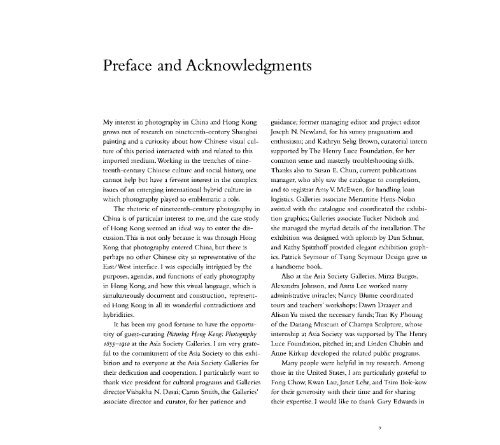picturing hong kong - HKU Libraries
picturing hong kong - HKU Libraries
picturing hong kong - HKU Libraries
You also want an ePaper? Increase the reach of your titles
YUMPU automatically turns print PDFs into web optimized ePapers that Google loves.
Preface and Acknowledgments<br />
My interest in photography in China and Hong Kong<br />
grows out of research on nineteenth-century Shanghai<br />
painting and a curiosity about how Chinese visual culture<br />
of this period interacted with and related to this<br />
imported medium. Working in the trenches of nineteenth-century<br />
Chinese culture and social history, one<br />
cannot help but have a fervent interest in the complex<br />
issues of an emerging international hybrid culture in<br />
which photography played so emblematic a role.<br />
The rhetoric of nineteenth-century photography in<br />
China is of particular interest to me, and the case study<br />
of Hong Kong seemed an ideal way to enter the discussion.<br />
This is not only because it was through Hong<br />
Kong that photography entered China, but there is<br />
perhaps no other Chinese city so representative of the<br />
East/West interface. I was especially intrigued by the<br />
purposes, agendas, and functions of early photography<br />
in Hong Kong, and how this visual language, which is<br />
simultaneously document and construction, represented<br />
Hong Kong in all its wonderful contradictions and<br />
hybridities.<br />
It has been my good fortune to have the opportunity<br />
of guest-curating Picturing Hong Kong: Photography<br />
1855—1910 at the Asia Society Galleries. I am very grateful<br />
to the commitment of the Asia Society to this exhibition<br />
and to everyone at the Asia Society Galleries for<br />
their dedication and cooperation. I particularly want to<br />
thank vice president for cultural programs and Galleries<br />
director Vishakha N. Desai; Caron Smith, the Galleries'<br />
associate director and curator, for her patience and<br />
guidance; former managing editor and project editor<br />
Joseph N. Newland, for his sunny pragmatism and<br />
enthusiasm; and Kathryn Selig Brown, curatorial intern<br />
supported by The Henry Luce Foundation, for her<br />
common sense and masterly troubleshooting skills.<br />
Thanks also to Susan E. Chun, current publications<br />
manager, who ably saw the catalogue to completion,<br />
and to registrar Amy V. McEwen, for handling loan<br />
logistics. Galleries associate Merantine Hens-Nolan<br />
assisted with the catalogue and coordinated the exhibition<br />
graphics; Galleries associate Tucker Nichols and<br />
she managed the myriad details of the installation. The<br />
exhibition was designed with aplomb by Dan Schnur,<br />
and Kathy Spitzhoff provided elegant exhibition graphics.<br />
Patrick Seymour of Tsang Seymour Design gave us<br />
a handsome book.<br />
Also at the Asia Society Galleries, Mirza Burgos,<br />
Alexandra Johnson, and Anna Lee worked many<br />
administrative miracles; Nancy Blume coordinated<br />
tours and teachers' workshops; Dawn Draayer and<br />
Alison Yu raised the necessary funds; Tran Ky Phoung<br />
of the Danang Museum of Champa Sculpture, whose<br />
internship at Asia Society was supported by The Henry<br />
Luce Foundation, pitched in; and Linden Chubin and<br />
Anne Kirkup developed the related public programs.<br />
Many people were helpful in my research. Among<br />
those in the United States, I am particularly grateful to<br />
Fong Chow, Kwan Lau, Janet Lehr, andTsim Bok-kow<br />
for their generosity with their time and for sharing<br />
their expertise. I would like to thank Gary Edwards in

















